Three painful memories in ocean
Three painful memories in ocean
Posted September. 11, 2020 07:36,
Updated September. 11, 2020 07:36


Tracking female divers, or haenyeos in Korean, who survived from a sunken passenger boat revealed a tragic story. The elderly in Gadeok Island all mentioned the sinking of Hanil when asked about the past events. “I still remember dozens of bodies laid on Mongdol beach near a breakwater. Only 12 survived out of over 100 who boarded the boat. It was a cold winter day with strong wind and high waves so it was a miracle that some of them swam for hours and survived. Four of the survivors were haenyeos who were used to swimming in the winter,” said the elderly. I was quite shocked at the following story of Hanil’s sinking in 1967.
On January 14, 1967, 140-ton passenger boat Hanil that traveled between Busan and Yeosu departed Yeosu with 108 passengers and 13 crew members on board. It collided with 1,900-ton marine destroyer Chungnam 73 in the northwest sea of Gadeok Island, Busan. Hanil, a wooden vessel, was heavily damaged and sank 10 minutes later, which led to the deaths of over 90 people. The investigation of the incident revealed that the engine of Hanil was the same engine used in Changkyung, which sank in 1953. Meanwhile, Changkyung was a repurposed boat by salvaging Cheonsanhwan, which used to travel between Busan and Shimonoseki during the Japanese colonial period and later sank from the bombing of the U.S. armed forces as it was mistakenly identified as a munitions boat. The 1954 sinking of Changkyung also caused hundreds of deaths and the engine of the boat was later reused in Hanil. Tragic incidents repeated from Cheonsanhwan to Changkyung, and later to Hanil.
Han Geon, a local historian of the Dadae port area, remembers the sinking of Changkyung. “The Dadae port coastal waters where Changkyung sank is a narrow strait called Hwajungumi between Hwasondae and Gori Island. It has such a strong current and wind that the fleet of Admiral Yi Sun-sin had to wait here for the wind to slow down during his sailing to Busan to repulse the Japanese military that occupied Busan port and Dadae port. Changkyung was recovered long past its sinking and the bone of missing passengers was found in the hull.” On Jan. 9, 1953, the number of deaths from the sinking of Changkyung, a regular ferry connecting Busan and Yeosu, exceeded the number of people recorded in the passenger list. The total number of deaths, including the bodies washed away, is estimated to be over 300. The main causes of the incident were thought to be the overcrowdedness and overloading of the ship. The passenger ship did not even have any survival equipment on board as it was stored in the warehouse of the ship’s owner due to concerns about theft.
The direct causes of the sinking of Cheonsanhwan, Changkyung, and Hanil may have been different – the bombing of the air force plane, the overloading and strong waves, and a collision with a battleship, respectively. However, they all had common factors, such as the repurposing of a ferry, overloading, and the lack of safety equipment. After such a shocking incident, a pop song titled “Hanil of Misfortune” was released. “Chocked scream in the night of cold northeaster. Many lives were taken away without even crying,” the song says. The new port in Busan, which can be overlooked from Gadeok Island, is expanding to a massive scale with the goal of becoming the top 3 container ports in the world with large ships traveling back and forth constantly. The peaceful ocean reflecting the sun may have forgotten the tragic history but we should remember that the tragedy was a disaster caused by human error, not nature.







